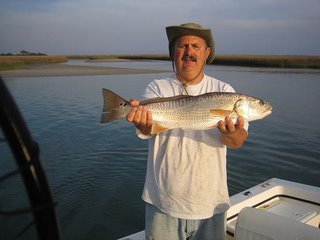Flounder Tips - techniques
This section of my Flounder fishing tips regards where to find the flounder. As with most fishing topics, there are lots of variables. Let's start with their habitat. Flounders are predators and their favorite tatic is the ambush. They have a great camouflage in their flat body and spotted topside, even their eyes are hard to detect. The shade of their skin can change depending on the enviroment. They lay on the bottom and wait for a potential meal to get close then they attack, they usually do not chase a meal far at all perefering to wait for it to come to them.
So you will need to put bait "on top" of them, so casting or drift fishing works best. You will want your bait to be on or close to the bottom. If you are casting, after you cast and tighten your line, let it set on the bottom for a 10-15 count then just pick up the rod tip and let it drop back down. Wait another 10 count then retreive a few feet of line and then pick up the rod tip again, repeating this until time to cast again. Another technique is the slow retrieve, just use a steady but slow retrieve with possibly an occasional pause. With either of these techniques, don't be surprise to get a "pick-up" on the downward movement of the bait.
Drift fishing for flounder is simliar to casting but you just leave the line out. Be sure to hold the rod, the flounder usually will not run with a bait so if you set the rod down you may not know if a flounder gets on until to late. When you feel him pick up your bait, let out a little bit of line to keep him from sensing the weight of the sinker. Then after a 30 count, gently tighten the line and set the hook. (see section on the hook-up).
Flounder are likely to spread out over a wide area so don't anchor in one spot for hours on end. On a falling tide drift around the mouths of inlets, rivers, and the edges of channel, rather than anchoring. On rising tides work the pilings around piers and docks by drifting past them as well.
Often you'll find them on the flats when there is enough water or up against the oyster rocks (little fish hang out there so flounder hide nearby waiting for a meal). Flounder like structure, sloughes, channels, holes, ledges and man made things like piers and bridges. When the water turns colder, look for them to move into deeper water and up on the mud bottoms instead of the sand (mud holds heat longer). Where small creeks and tidal ditches empty into bigger water can be productive places too.
Remember...think ambush....where would an ambush loving fish be found?


0 Comments:
Post a Comment
<< Home